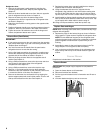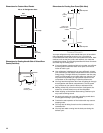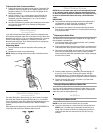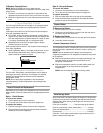
14
Dimensions for Custom Wood Panels
Dimensions for Routing Handle Side of Raised Door
Panels (End View)
Dimensions for Routing Door Panel (Side View)
Normal Sounds
Your new refrigerator may make sounds that your old one didn’t
make. Because the sounds are new to you, you might be
concerned about them. Most of the new sounds are normal. Hard
surfaces, such as the floor, walls, and cabinets, can make the
sounds seem louder. The following describes the kinds of sounds
and what may be making them.
■ If your refrigerator is equipped with an ice maker, you will hear
a buzzing sound when the water valve opens to fill the ice
maker for each cycle.
■ Your refrigerator is designed to run more efficiently, to keep
your food items at the desired temperatures and to minimize
energy usage. The high efficiency compressor and fans may
cause your refrigerator to run longer than your old one. You
may also hear a pulsating or high-pitched sound from the
compressor or fans adjusting to optimize performance.
■ You may hear the evaporator fan motor circulating air through
the refrigerator and freezer compartments. The fan speed
may increase as you open the doors or add warm food.
■ Rattling noises may come from the flow of refrigerant, the
water line, or items stored on top of the refrigerator.
■ Water dripping on the defrost heater during a defrost cycle
may cause a sizzling sound.
■ As each cycle ends, you may hear a gurgling sound due to
the refrigerant flowing in your refrigerator.
■ Contraction and expansion of the inside walls may cause a
popping noise.
■ You may hear air being forced over the condenser by the
condenser fan.
■ You may hear water running into the drain pan during the
defrost cycle.
20 cu. ft. Refrigerator door
A.Handle
B.Door panel
35
5
/
8"
(90.5 cm)
36
1
/
16"
(91.6 cm)
42"
(106.7 cm)
23
1
/
4"
(59.1 cm)
B
A
2¹⁄₂" (6.35 cm)
min.
¹⁄₄" (6 mm) max.
¹⁄₂"
(1.3 cm)
min.
¹⁄₄"
(6.35 mm) max.
Top
Bottom
³⁄₈"
(9.5 mm)
min.
¹⁄₄"
(6.35 mm) max.
Center face
detail between
offsets


















